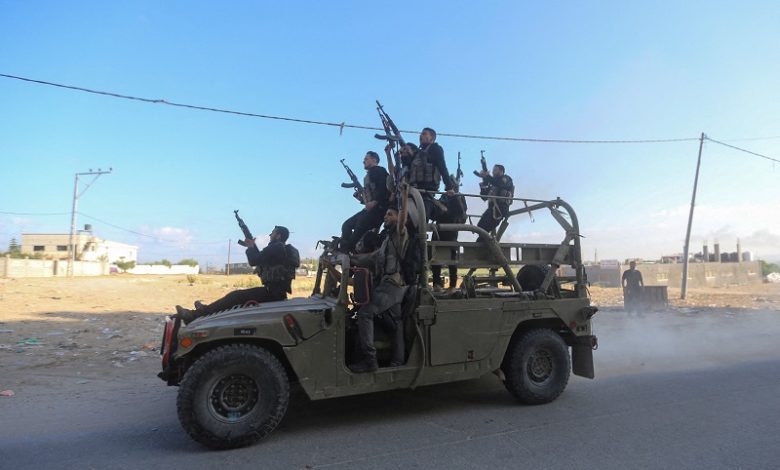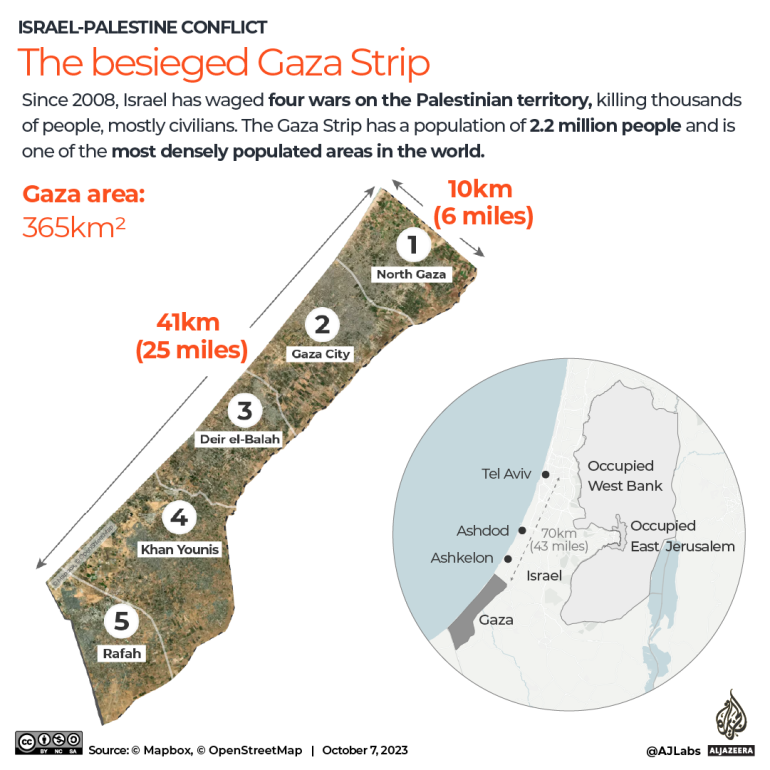
Israel and the armed Palestinian group Hamas are locked in an escalating conflict that has left almost 1,000 people dead in a little more than a day.
On Saturday, Hamas launched an unprecedented attack on Israel, blowing up parts of the country’s highly fortified separation fence and sending fighters into Israeli communities along the Gaza frontier.
The move prompted the government of Prime Minister Benjamin Netanyahu to warn of “a long and difficult war”. Israeli jets are bombing the Gaza Strip, levelling high rises and civilian neighbourhoods.
But what is Hamas, the group at the centre of it all? Here is what to know:
What is the group Hamas?
Hamas stands for the Islamic Resistance Movement and in Arabic means “zeal”.
The group politically controls the Gaza Strip, a territory of about 365sq km (141sq miles) that is home to more than two million people but is blockaded by Israel.
Hamas has been in power in the Gaza Strip since 2007 after a brief war against Fatah forces loyal to President Mahmoud Abbas, the head of the Palestinian Authority and Palestine Liberation Organization (PLO).
When was Hamas formed and what is its aim?
The Hamas movement was founded in Gaza in 1987 by an imam, Sheikh Ahmed Yasin, and his aide Abdul Aziz al-Rantissi shortly after the start of the first Intifada, an uprising against Israel’s occupation of the Palestinian territories.
The movement started as an offshoot of the Muslim Brotherhood in Egypt and created a military wing, the Izz al-Din al-Qassam Brigades, to pursue an armed struggle against Israel with the aim of liberating historic Palestine.
It also offered social welfare programmes to Palestinian victims of the Israeli occupation.
What are the Palestinian group’s principles?
Unlike the PLO, Hamas does not recognise Israel’s statehood but accepts a Palestinian state on 1967 borders.
“We shall not waive an inch of the Palestinian home soil no matter what the recent pressures are and no matter how long the occupation,” Khaled Meshaal, the leader-in-exile of the Palestinian group said in 2017.
Hamas violently opposes the Oslo peace accords negotiated by Israel and the PLO in the mid-1990s.
It is formally committed to establishing a Palestinian state within its own borders. It has pursued this aim through attacks on Israeli soldiers, settlers and civilians both in the occupied Palestinian territories and in Israel.
The group as whole or in some instances its military wing is designated as a “terrorist” organisation by Israel, the United States, European Union, Canada, Egypt and Japan.


Who are its allies and supporters?
Hamas is part of a regional alliance that also includes Iran, Syria and the group Hezbollah in Lebanon, which opposes US policies towards the Middle East and Israel.
Hamas and Islamic Jihad, the second-largest armed group in the region, are often united against Israel and are the most important members of the joint operations room that coordinates military activity among the various armed groups in Gaza.
The relationship between the two groups has been tense when Hamas has exerted pressure on Islamic Jihad to stop attacks against Israel.
What prompted Saturday’s attack on Israel?
Hamas spokesperson Khaled Qadomi told Al Jazeera that the group carried out its military operation in response to atrocities that Palestinians have faced over decades.
“We want the international community to stop atrocities in Gaza against Palestinian people, our holy sites like Al-Aqsa [Mosque]. All these things are the reason behind starting this battle,” he said.
Hamas also called on other groups to join the fight, saying Saturday’s attacks were just the beginning.
Is Hamas targeting civilians?
Osama Hamdan, senior spokesperson for Hamas, told Al Jazeera that the group was not attacking civilians even though the group’s own videos have shown its fighters taking elderly Israelis hostage during the fighting on Saturday.
Rights groups such as Amnesty International have also pointed out that Israeli civilians had been killed by Hamas.
But Hamdan insisted that the group was attacking only settlers living in illegal settlements, whom he described as legitimate targets.
“You have to differentiate between settlers and civilians. Settlers attacked Palestinians,” Hamdan said.
Asked whether civilians in southern Israel were also considered settlers, Hamdan said: “Everyone knows there are settlements there.”
“We are not targeting civilians on purpose. We have declared settlers are part of the occupation and part of the armed Israeli force. They are not civilians,” he added.
How was the group able to carry out the attack?
Hamas said its fighters took several Israelis captive in the enclave, releasing videos of fighters dragging bloodied soldiers. It said senior Israeli military officers were among the captives.
The videos could not immediately be verified but matched geographic features of the area. Fears that Israelis have been kidnapped evoked memories of the 2006 capture of soldier Gilad Shalit, whom Hamas-linked fighters seised in a cross-border raid. Hamas held Shalit for five years until he was exchanged for more than 1,000 Palestinian prisoners held by Israel.
Hamas also sent paragliders flying into Israel, the Israeli military said. The attack recalled a famous assault in the late 1980s when Palestinian fighters crossed from Lebanon into northern Israel on hang-gliders and killed six Israeli soldiers. (Al Jazeera)


